Yuri Verkhoshansky and Mel Siff – Supertraining 6th Exp. Ed. 2009
supertraining.pdf
[1 eBook – PDF]
Description
Supertraining Sixth Edition Expanded Version by Dr. Yuri V. Verkhoshansky and Dr. Mel C. Siff, 2009This is a elib.tech Exclusive. Leaking it will result in a permanent ban.GB ThreadContributors: nowElite/VIP: 2 weeksPower Users (PU): 2 monthsUsers: never CONTENTSAcknowledgements………………………………………………………………………………………….i1. STRENGTH AND THE MUSCULAR SYSTEM…………………………………………1 objectives What is Strength? The Origins of Strength Training Science Pioneers of Strength Training The Divergence of Training Philosophies The Modern Era Dawns The Fundamental Principle of Strength Training Neural Changes with Training Strength Deficit1.1 Preliminary Issues………………………………………………………………………….10 1.1.1 Resistance Training for Different Purposes…………………………………………………10 1.1.2 Factors limiting Strength Production……………………………………………………….12 Trainability Neuromuscular Efficiency Biomechanical Efficiency Psychological Factors Pain and Fear of Pain Injury and Fear of Injury Fatigue1.2 Fundamental Biomechanics of Strength…………………………………………………17 Biomechanics and Training Initial Implications of Mechanics Mass and Acceleration Issues Muscle Tension and Training Stimulus Application of Basic Biomechanics1.3 A Philosophy of Physical Training……………………………………………………….241.4 Specificity in Training…………………………………………………………………….271.5 Strength and Fitness………………………………………………………………………32 Fitness, Preparedness and Work Capacity1.6 The Nature of Strength……………………………………………………………………33 Determinants of Strength Shock Training and Plyometrics Strength and Connective Tissue1.7 The Muscle Complex………………………………………………………………………35 1.7.1 The Structure of Muscle……………………………………………………………………35 Further Muscle Research 1.7.2 A Model of the Muscle Complex………………………………………………………….40 Further Information on Collagenous Tissues The Structure and Function of Ligaments and Tendons Mechanical Loading of Collagenous Tissue The Role of Stored Elastic Energy The Influence of Exercise on Connective Tissue A Modified Muscle Model 1.7.3 Implications of the Muscle Model for Flexibility…………………………………………..48 1.7.4 The Relationship between Stability and Mobility………………………………………….481.8 Classification of Muscle Actions………………………………………………………….491.9 Cocontraction and Ballistic Movement…………………………………………………..501.10 Types of Muscle Action…………………………………………………………………..51 Quasi-isometric Action1.11 The Triphasic Nature of Muscle Action…………………………………………………541.12 Types of Muscle Fibre……………………………………………………………………55 Slow and Fast Twitch Muscle Fibres Muscle Protein Isoforms Muscle Fibres and Training Further Aspects of Muscle Plasticity The Implications of Ballistic Research1.13 The Mechanism of Muscle Growth………………………………………………………65 The Effects of High versus Moderate Intensity Exercise1.14 Neurophysiological Aspects of Exercise…………………………………………………691.15 Bioenergetics and the Energy Systems…………………………………………………..73 1.15.1 The Energy Systems and Types of Activity……………………………………………..74 1.15.2 Energy Mechanisms……………………………………………………………………..75 1.15.3 The Short-Term Energy System …………………………………………………………76 1.15.4 The Intermediate Energy System ……………………………………………………….77 1.15.5 The Long-Term Energy System…………………………………………………………78 1.15.6 Implications for Physical Conditioning………………………………………………….79 1.15.7 Hormonal Factors and Strength Training………………………………………………..821.16 Adaptation and the Training Effect……………………………………………………..82 The Effects of Stress 1.16.1 The General Adaptation Syndrome……………………………………………………….83 Adaptive Reconstruction versus Supercompensation 1.16.2 The Biochemistry of Adaptation in Sport…………………………………………………85 The Specificity of Biochemical Adaptation The Sequence of Biochemical Changes during Training 1.16.3 General Theories of the Training Process…………………………………………………87 Single-Factor Model of Training Two-Factor Model of Training The Concept of Progressive Overload Training 1.16.4 A Model of Physical Fitness………………………………………………………………912. SPORT SPECIFIC STRENGTH TRAINING…………………………………………..95 Special Strength Training The Russian System of Classifying Athletes The Early Stages of Strength Training2.1 Schemes for Perfecting Movements………………………………………………………97 2.1.1 Increasing the Working-Effect of Movements ……………………………………………97 2.1.2 Perfecting the Motor Structure of Sports Movements …………………………………….100 The Kinematic Pair The Kinematic Chain The Kinematic System 2.1.3 Perfecting the Kinesiological Pattern of Movements……………………………………..1052.2 Specialisation to Develop Sports Mastery………………………………………………107 2.2.1 Specific Forms of Producing Muscular Strength………………………………………107 2.2.2 Sports Implications of Strength Indices…………………………………………………109 2.2.3 The Functional Topography of the Muscular System …………………………………110 2.2.4 Motor Specialisation in Developing Sports Mastery……………………………………112 Heterochronicity Specialisation Processes2.3 Characteristics of Physical Fitness………………………………………………………116 2.3.1 The Structure of Physical Fitness…………………………………………………………116 2.3.2 The Interrelation between Motor Abilities………………………………………………..117 General and Partial Connections Essential and Non-essential Connections Positive and Negative Connections Direct and Indirect Connections 2.3.3 The Structure of Motor Abilities…………………………………………………………..120 2.3.4 General Concepts of the Structure of Physical Fitness……………………………………1203. FACTORS INFLUENCING STRENGTH PRODUCTION…………………………..1253.1 The Regimes of Muscular Work………………………………………………………..1253.2 Qualitative Characteristics of Strength…………………………………………………129 3.2.1 Explosive Strength…………………………………………………………………………129 Quickness and Reactive Ability Speed, Speed-Strength and Quickness 3.2.2 Strength-Endurance……………………………………………………………………….1423.3 The Influence of External Conditions on Strength……………………………………..144 3.3.1 The Influence of the Pre-working State of the Muscles…………………………………..144 3.3.2 The Effect of the Load on Speed of Muscle Contraction…………………………………146 Contraction Speed and Strength in Acyclic Activity Limitations of the Force-Velocity Relationship Contraction Strength and Speed in Cyclic Activities 3.3.3 The Effect of Strength on Speed of Muscle Action……………………………………….149 Speed-Strength and Strength-Speed The Interrelation between Strength and Other Fitness Factors 3.3.4 The Relationship between Strength and Posture………………………………………….152 3.3.4.1 Strength Variation with Postural Change……………………………………………….152 3.3.4.2 Strength, Safety and Pelvic Tilt…………………………………………………………153 3.3.4.3 The Effect of Head Position on Strength………………………………………………..154 3.3.4.4 Strength, Symmetry and Limb Alignment……………………………………………….155 3.3.5 The Dependence of Strength on Bodymass……………………………………………….155 3.3.6 The Relationship between Strength and Height……………………………………………159 3.3.7 The Relationship between Strength and Age………………………………………………159 3.3.8 The Relationship between Strength and Gender…………………………………………..161 3.3.9 The Increase in Human Strength over Time………………………………………………1613.4 Factors increasing the Working Effect of Strength……………………………………162 3.4.1 The Warm-up and Pre-Activity Preparation……………………………………………162 3.4.2 The After-effect of Muscle Activity……………………………………………………164 3.4.3 Additional Movement…………………………………………. ………………………166 3.4.4 Preparatory Movement …………………………………………………………………167 3.4.5 Coordination in Muscular Work…………………………………………………………167 3.4.6 Efficiency of Energy Expenditure……………………………………………………….168 3.4.7 Emotion and other Psychological Factors……………………………………………….170 3.4.8 The Effect of Cold Application………………………………………………………….171 3.4.9 Breathing and Strength Production………………………………………………………172 3.4.10 Strength Development and Proprioception ……………………………………………..1733.5 Flexibility and Sporting Performance…………………………………………………..174 3.5.1 A Definition of Flexibility………………………………………………………………174 3.5.2 The Effects of Stretching……………………………………………………………….176 3.5.3 The Neuromuscular Component of Flexibility…………………………………………176 3.5.4 Components of Joint Flexibility………………………………………………………..179 3.5.5 Parameters of Flexibility………………………………………………………………..179 3.5.6 Soft Tissue Biomechanics and Flexibility………………………………………………180 Flexibility, Stability and Muscle Activity 3.5.7 The Influence of Exercise on Connective Tissue…………………………………………182 3.5.8 Stretching Techniques……………………………………………………………………183 The Use of Ballistic Stretching 3.5.9 Low Flexibility versus Non-Functional Muscle Tension………………………………..1873.6 The Stretching Matrix System……………………………………………………………188 Is Stretching Always Necessary?3.7 The Movement Matrix System…………………………………………………………..193 Limitations of Anatomical Movement Analysis4. THE MEANS OF SPECIAL STRENGTH TRAINING………………………………..2014.1 The Problem of Training Means…………………………………………………………201 4.1.1 Characteristics of Strength Increase………………………………………………………201 4.1.2 The Effect of Strength Training Means …………………………………………………..204 Algebraic Relations and Training Steps Towards Structuring the Training Process4.2 Different Means of Strength Development……………………………………………..207 4.2.1 Electrostimulation………………………………………………………………………..208 4.2.1.1 The Physiological Effects of Electrostimulation……………………………….208 4.2.1.2 Reasons for Conflicting Research ………………………………………………209 4.2.1.3 Clinical Applications of Electrostimulation……………………………………210 4.2.1.4 Further Research Findings………………………………………………………213 4.2.1.5 An Integrated Theory of Electrostimulation …………………………………..214 4.2.1.6 The Use of Electrostimulation in Training……………………………………..214 The Integrated Use of Electrostimuiation Sports Functional Electrostimulation Overtraining and Restoration Concluding Remarks 4.2.2 Resistance and Strength Training………………………………………………………216 4.2.3 Kinetic Energy and Strength Processes…………………………………………………220 4.2.4 Isometric Training………………………………………………………………………223 Isometric Training and Angular Specificity Isometric Endurance Recovery after Isometric Activity Other Aspects of Isometric Activity Loadless Training 4.2.5 Eccentric Training…………………………………………………………………………230 4.2.6 Isokinetic and Other Training Means……………………………………………………..231 4.2.6.1 The Isokinetic Training Method ……………………………………………….231 4.2.6.2 Limitations of the Isokinetic Method ………………………………………….233 Fundamental Biomechanics of Isokinetic Devices Recommended Strength Ratios Functional Anatomy Muscle Physiology The Importance of Specificity Concluding Remarks 4.2.6.3 Static-Dynamic Methods………………………………………………………236 4.2.6.4 Choice of Muscle Training Regimes…………………………………………….236 4.2.7 The Use Of Training Machines……………………………………………………………237 4.2.7.1 Functional Resistance Machines………………………………………………..237 4.2.7.2 Non-Functional Resistance Machines…………………………………………..238 4.2.7.3 Machines and the Variable Resistance Philosophy…………………………….239 4.2.7.4 The Training Safety of Machines………………………………………………239 4.2.7.5 The Efficiency of Machine Training……………………………………………239 4.2.8 The Concept of Symmetric Training……………………………………………………..240 4.2.9 The Concept of Muscle Isolation ………………………………………………………..2414.3 Dynamic Correspondence as a Means of Strength Training…………………………..241 4.3.1 The Amplitude and Direction of Movement……………………………………………..242 Parachute Resistance Training 4.3.2 The Accentuated Region of Force Production…………………………………………….244 4.3.3 The Dynamics of the Effort……………………………………………………………….245 4.3.4 The Rate and Time of Maximal Force Production………………………………………..246 4.3.5 The Regime of Muscular Work……………………………………………………………247 4.3.6 Correspondence of Training Means to the Sports Movements…………………………..2474.4 Strength Training and General Endurance……………………………………………248 Oxidative Capacity and Muscular Endurance Strength Training and General Endurance The Process of Functional Specialisation Factor Analysis5. THE METHODS OF SPECIAL STRENGTH TRAINING……………………………2555.1 The Problem of Methods…………………………………………………………………255 Some Implications of the Laws of Dynamics5.2 General Principles of Special Strength Training………………………………………257 5.2.1 The Development of Maximum Strength ………………………………………………..258 The Repetitive Effort Method The Brief Maximal Tension Method 5.2.2 Autoregulating Progressive Resistance Exercise (APRE)…………………………………261 5.2.3 The Development of Speed-Strength……………………………………………………..264 5.2.4 The Development of Explosive Strength and Reactive Ability…………………………..267 The Plyometric Method Plyometrics as a Discrete Training System Plyometric Training and Safety The Fundamental Theory of Plyometrics The Prescription of Plyometric Exercise Asymmetric Plyometrics Non-Impact Plyometrics Non-Impact Plyometrics in Sports Training Resisted and Water Plyometric Training Analysis of Popular Texts on Plyometrics Plyometrics and the Brain Various Shock Methods 5.2.5 The Development of Strength-Endurance…………………………………………………2855.3 Application of Special Strength Training Means……………………………………….287 5.3.1 Interaction between Different Training Means………………………………………….291 5.3.2 A Sequential System of Training Means………………………………………………..291 5.3.3 The Conjugate Sequence System of Training Means…………………………………..2925.4 The Principal Aims of Special Strength Training………………………………………294 5.4.1 Converging the Partial Effects of Strength Training Means……………………………294 5.4.2 Acceleration of Specific Adaptation ……………………………………………………296 5.4.3 Specific Correspondence of The Training Effect ………………………………………296 5.4.4 Maintaining the Strength Training Effect………………………………………………2975.5 Cross Training in Sport……………………………………………………………….2985.6 Circuit Training……………………………………………………………………….3006. ORGANISATION OF TRAINING………………………………………………….3136.1 The Development of Training Organisation…………………………………………313 Ways of Organising Training……………………………………………………………………………3146.2 Periodisation as a Form of Organisation…………………………………………….316 Definitions and Fundamental Concepts Preparatory Phases of Training Further Phases and Principles Acquisition and Stabilisation of Technical Skills 6.2.1 Types of Periodisation…………………………………………………………………….319 6.2.2 Calculation of the Parameters of Periodisation …………………………………………..323 Drawing up the Periodisation Scheme Cybernetic Programming and Periodisation Training Intensity, Heart Rate and Other Tests Non Technological Testing 6.2.3 The Relationship between Intensity and Volume…………………………………………3326.3 The Periodisation Controversy……………………………………………………….333 Chronobiology and Periodisation6.4 Training as an objective of Management……………………………………………3366.5 Prerequisites for Organising Training……………………………………………….3386.6 Basic Management Theory……………………………………………………………339 6.6.1 Human Needs and Motivation ……………………………………………………………339 Maslow’s Hierarchy of Needs Other Theories of Needs Expectancy Theory of Motivation 6.6.2 Management Models ………………………………………………………………………342 The Traditional Model The Managerial Grid Situational Leadership The Leadership Continuum Decision Making and Problem Solving6.7 Classification of Sports………………………………………………………………..3456.8 Characteristics of the Training Process………………………………………………346 6.8.1 Adaptation to Intense Muscular Work…………………………………………………346 6.8.2 Structural-Functional Specialisation in Training……………………………………….350 6.8.3 The Structure of Special Physical Preparedness ……………………………………….3526.9 Preparedness and the Training Load…………………………………………………..352 6.9.1 The Training Load and its Effect…………………………………………………………352 6.9.2 Factors determining the Training Effect ………………………………………………….355 6.9.3 The Contents of the Loading ………………………………………………………………356 Specificity of the Load Training Potential of the Loading 6.9.4 The Volume of the Training Load…………………………………………………………358 6.9.5 The Organisation of Training Loads ………………………………………………………3596.10 The Long-Term Delayed Training Effect……………………………………………..362 The Delayed Training Effect and Long Duration Work Concluding Comments6.11 The Dynamics of Training in the Annual Cycle………………………………………3686.12 Principles of Programming and Organising Training……………………………….368 6.12.1 Forms of Constructing Training…………………………………………………………368 6.12.2 Organisational Aspects of Structuring Training…………………………………………368 Complex Training Unidirectional Training Concentrated Loading Problems with Concentrated Loading The Use of Concentrated Loading Use of the Conjugate Sequence System 6.12.3 Constructing Training by Functional Indicators…………………………………………3746.13 Primary Aims in Programming Training………………………………………………3786.14 Models for Structuring Annual Training………………………………………………379 Examples of Descriptive Modelling The Composition of the Concentrated Loading Volume 6.14.1 A Model for Sports requiring Explosive Strength……………………………………….383 6.14.2 A Model for Medium Duration Endurance Sports ………………………………………384 6.14.3 A Model for Long Duration Endurance Sports………………………………………….385 6.14.4 A Model for Sports requiring Tricyclic Periodisation……………………………………386 More Advanced Use of Concentrated Loading 6.14.5 Practical Principles of Programming…………………………………………………….3896.15 A Sequence for Programming Annual Training………………………………………3896.16 Managing the Training Process………………………………………………………..3916.17 The Future of Programming Training…………………………………………………3927. STRENGTH TRAINING METHODS…………………………………………………3937.1 Bodybuilding and Other Strength Training Methods…………………………………394 Maximal Methods Supramaximal Methods Circa-maximal Methods Submaximal Methods Reactive Methods Miscellaneous Methods Methods for Overcoming Barriers Concluding Remarks7.2 PNF as a Training System………………………………………………………………403 7.2.1 Definition and Scope of PNF………………………………………………………………404 7.2.2 Relationship of PNF to Physical Conditioning……………………………………………405 7.2.3 The Fundamentals of PNF…………………………………………………………………405 7.2.3.1 The Principles of PNF…………………………………………………………………..405 7.2.3.2 Procedures of PNF………………………………………………………………………406 7.2.3.3 Patterns of PNF………………………………………………………………………….407 7.2.3.4 Positions and Postures of PNF…………………………………………………………..410 7.2.3.5 Pacing in PNF……………………………………………………………………………410 7.2.4 Modifications to PNF……………………………………………………………………..410 Pattern Deviations and Safety Factors 7.2.5 Functional Neuromuscular Conditioning…………………………………………………4117.3 Combinations of Resistance Methods………………………………………………….411 Scientific Analysis of Different Combinations……………………………………………………………412 Accelerated Powermetrics…………………………………………………………………………………4157.4 Muscle Training…………………………………………………………………………416 7.4.1 A Summary of Movements of the Joints…………………………………………………416 7.4.2 Examination of Some Joint Actions ………………………………………………………4187.5 Use of the Strength Training Compendium……………………………………………4187.6 Training for Hypertrophy?………………………………………………………………………………..4198. DESIGNING SPORT SPECIFIC STRENGTH PROGRAMMES…………………4218.1 Preliminary Considerations…………………………………………………………..4218.2 Needs Analysis and Sports Modelling………………………………………………..423 Selection of Training Needs General Fitness Issues Injuries Training to Avoid Injury Training of the Soft Tissues8.3 The Training Programme………………………………………………………………428 Components of the Training Programme Statute of Fitness Limitations The Minimax Principle and Training Economics List of Popular Resistance Exercises8.4 Classification of Exercises for Sports Training………………………………………..433 8.4.1 Principles of Exercise Classification………………………………………………………433 8.4.2 Classification of Weightlifting Exercises…………………………………………………434 Categorisation of Fundamental and Additional Exercises General Preparatory Exercises in Weightlifting List of Exercises in Weightlifting Training Examples of Powerlifting Exercises Examples of Hybrid Lifting Exercises8.5 Overtraining……………………………………………………………………………..4418.6 Restoration and Stress Management…………………………………………………..444 Stress and Restorative Measures Application of Restorative Measures Restorative Means Massage Methods Massage Variables Further Fundamentals of Sports Recovery Complexes and Periodisation in Restoration Research into Restoration Methods Sports Science and Stress Management8.7 The Use Of Testing………………………………………………………………………456 The Vertical Jumping Test Muscle Strength Ratios Work Capacity and Functional Pressure Tests8.8 Injury and Safety in Strength Training………………………………………………..460 Biomechanics of the Injury Process General Biomechanical Causes of Injury Injury Prevention by Imperfection Training8.9 Safety and Training Apparel……………………………………………………………467 8.9.1 Lifting, Belts and Breathing ………………………………………………………………467 8.9.2 Shoes and Safety…………………………………………………………………………..468 Shoe Design Shoes in the Weights Facility8.10 Safety and Machine Training…………………………………………………………..4698.11 Protection by the Muscles………………………………………………………………4728.12 Towards the Future……………………………………………………………………473 Non-Physical Factors Lessons from Modern Physics Changes of State Fuzzy Fitness Application of New Methods Innovations in Testing Kinaesthetic Manipulation and Education Advances in Methods of Coaching Concluding RemarksREFERENCES AND BIBLIOGRAPHY……………………………………………………481INDEX………………………………………………………………………………………….4959. ADDENDUM………………………………………………………………………………5039.1 Laws of Sports Mastery: Principles of Training………………………………………..504 Introduction………………………………………………………………………………………….504 9.1.1. Understanding compensatory adaptation………………………………………………….510 9.1.2. Current adaptation reserves of the body……………………………………………………510 9.1.3. The adaptation strategy……………………………………………………………………511 9.1.4. Specificity of protein synthesis during adaptation…………………………………………513 9.1.5. Essentials of the constructive effects of the adaptational process…………………………519 9.1.6. Heterochronism of the adaptational restructuring…………………………………………527 9.1.7. Functional economy of the adapted body…………………………………………………530 9.1.8. The optimal regime of adaptation…………………………………………………………533 9.1.9. The phenomena of decreasing of immunological reactivity………………………………541 9.1.10. General schematic of the adaptational process during sports activity………………….542 CONCLUSIONS……………………………………………………………………………………544 Bibliography in Russian……………………………………………………………………552 Bibliography not in Russian………………………………………………………………..5569.2 The Shock Method for Developing Power………………………………………………563 What is reactive ability?………………………………………………………………………………………………………563 What is the Shock method?………………………………………………………………………………………………….563 History of the Shock Method………………………………………………………………………..563 Guidelines for using the shock method………………………………………………………………565 Technique of the depth jump………………………………………………………………………..565 Recommendations for using depth-jumps…………………………………………………………..566 Program to develop explosive strength and reactive ability of the leg muscles…………………….567 Program for Perfecting Starting Acceleration………………………………………………………572 Program for improvement of ball throwing speed…………………………………………………..575 CONCLUSIONS……………………………………………………………………………………577
You must be logged in to post a review.

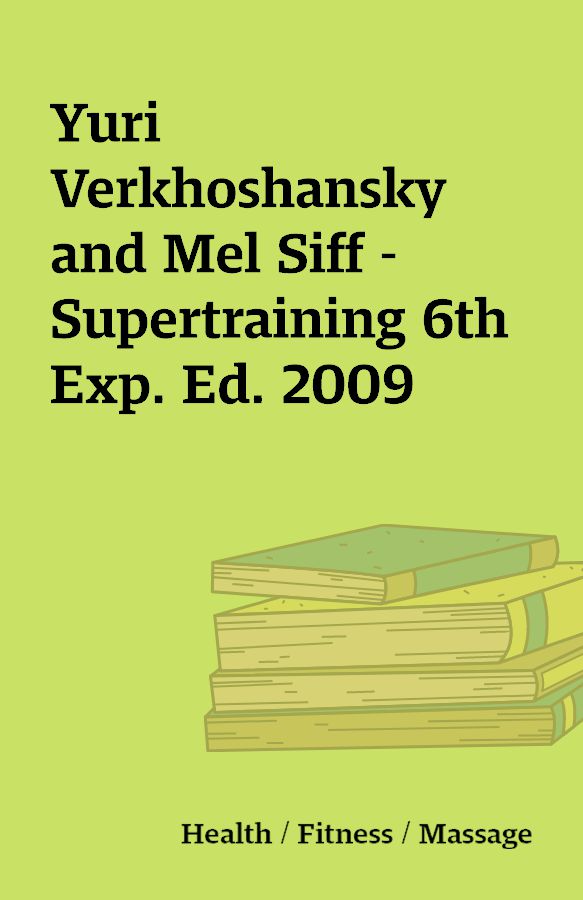
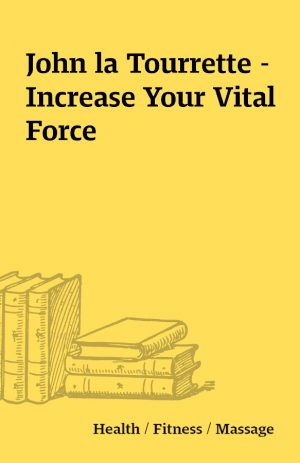
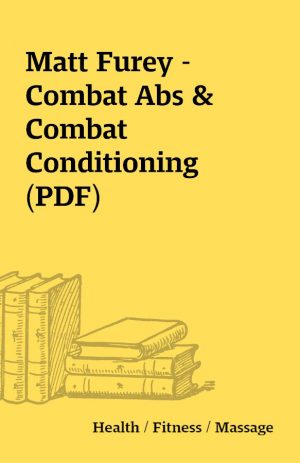
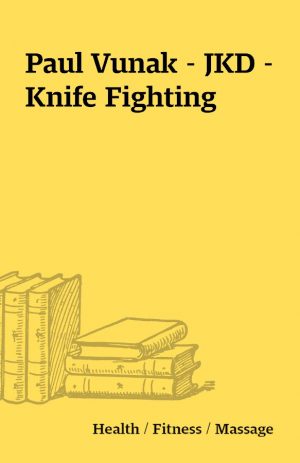
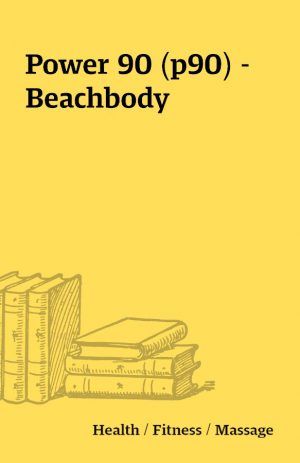
Reviews
There are no reviews yet.